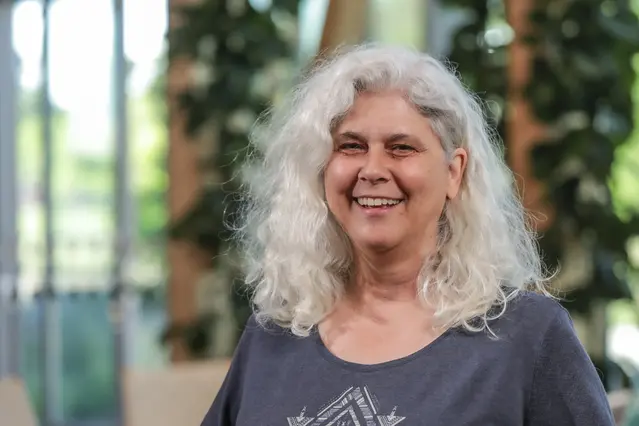Ana Cristina Carvalho
Air Quality researcher, Ph.D. and research leader.

Ana Cristina Carvalho.
Contact, network and CV
- Email: ana.carvalho@smhi.se
- Phone: +46 11 4958019
- Research Gate ID: Ana-Cristina-Carvalho-2
 External link.
External link.
Publications
Fields of work
Mesoscale air quality modelling over Europe, and zoomed to metropolitanean areas, aiming to understand the processes leading to air pollution events, such as stratospheric ozone down to the surface, and particulate matter dust outbreaks. Air quality climatology on both measured and modelled data.
Research Interests
- Ozone transport and production
- Particulate matter
- Statistical analysis of meteorological and air quality data
Special competences
Regional air quality modelling, students supervision, research project coordination at national level.
Latest publications
Technical note
Marc Guevara, Augustin Colette, Antoine Guion, Valentin Petiot, Mario Adani, Joaquim Arteta, Anna Benedictow, Robert Bergström, Andrea Bolignano, Paula Camps, Ana Cristina Carvalho, Jesper Heile Christensen, Florian Couvidat, Ilaria D'Elia, Hugo Denier van der Gon, Gael Descombes, John Douros, Hilde Fagerli, Yalda Fatahi, Elmar Friese, Lise Frohn, Michael Gauss, Camilla Geels, Risto Hanninen, Kaj Hansen, Oriol Jorba, Jacek W. Kaminski, Rostislav Kouznetsov, Richard Kranenburg, Jeroen Kuenen, Victor Lannuque, Frederik Meleux, Agnes Nyiri, Yuliia Palamarchuk, Carlos Perez Garcia-Pando, Lennart Robertson, Felicita Russo, Arjo Segers, Mikhail Sofiev, Joanna Struzewska, Renske Timmermans, Andreas Uppstu, Alvaro Valdebenito, Zhuyun Ye
Copernicus Atmosphere Monitoring Service - Regional Air Quality Production System v1.0
Augustin Colette, Gaelle Collin, Francois Besson, Etienne Blot, Vincent Guidard, Frederik Meleux, Adrien Royer, Valentin Petiot, Claire Miller, Oihana Fermond, Alize Jeant, Mario Adani, Joaquim Arteta, Anna Benedictow, Robert Bergström, Dene Bowdalo, Jorgen Brandt, Gino Briganti, Ana Cristina Carvalho, Jesper Heile Christensen, Florian Couvidat, Ilaria D'Elia, Massimo D'Isidoro, Hugo Denier van der Gon, Gael Descombes, Enza Di Tomaso, John Douros, Jeronimo Escribano, Henk Eskes, Hilde Fagerli, Yalda Fatahi, Johannes Flemming, Elmar Friese, Lise Frohn, Michael Gauss, Camilla Geels, Guido Guarnieri, Marc Guevara, Antoine Guion, Jonathan Guth, Risto Hanninen, Kaj Hansen, Ulas Im, Ruud Janssen, Marine Jeoffrion, Mathieu Joly, Luke Jones, Oriol Jorba, Evgeni Kadantsev, Michael Kahnert, Jacek W. Kaminski, Rostislav Kouznetsov, Richard Kranenburg, Jeroen Kuenen, Anne Caroline Lange, Joakim Langner, Victor Lannuque, Francesca Macchia, Astrid Manders, Mihaela Mircea, Agnes Nyiri, Miriam Olid, Carlos Perez Garcia-Pando, Yuliia Palamarchuk, Antonio Piersanti, Blandine Raux, Miha Razinger, Lennart Robertson, Arjo Segers, Martijn Schaap, Pilvi Siljamo, David Simpson, Mikhail Sofiev, Anders Stangel, Joanna Struzewska, Carles Tena, Renske Timmermans, Thanos Tsikerdekis, Svetlana Tsyro, Svyatoslav Tyuryakov, Anthony Ung, Andreas Uppstu, Alvaro Valdebenito, Peter van Velthoven, Lina Vitali, Zhuyun Ye, Vincent-Henri Peuch, Laurence Rouil
Large-scale evaluation of WRF-chem model and dry deposition schemes during a Saharan dust event over the Iberian Peninsula
Rui Silva, Ana Cristina Carvalho, David Carvalho, Alfredo Rocha
